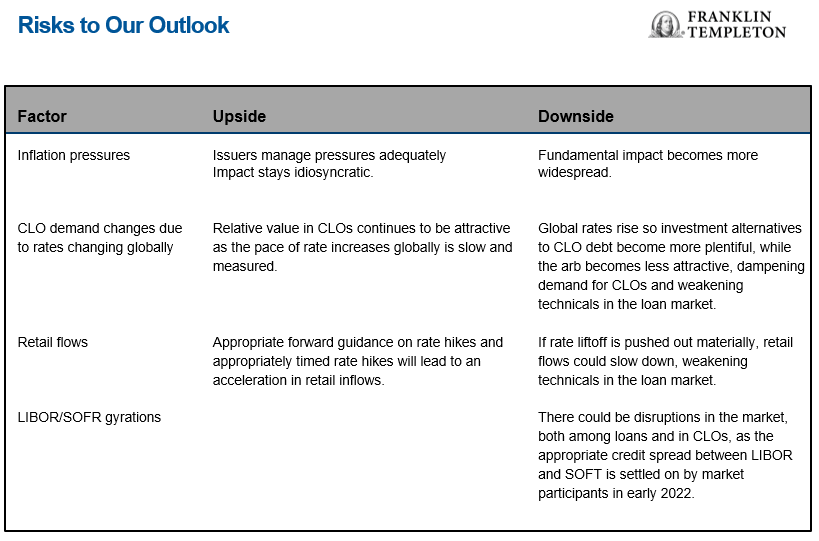KanawatTH/iStock via Getty Images
By Reema Agarwal, CFA, Director, Floating Rate Debt, Franklin Templeton Fixed Income
The technical and fundamental picture looks favorable for bank loans for a number of reasons, according to Reema Agarwal, Franklin Templeton Fixed Income’s Director of Floating Rate Debt. She says current spreads look attractive amid what is likely to be a period of monetary policy tightening over the course of the year, and periods of volatility should be considered buying opportunities.
Note: the video below was recorded in December 2021. References to “next year” thus refer to 2022.
Except for a brief pause around the COVID-19 Omicron variant discovery, loan spreads have continued their steady march tighter, more so since mid-September, when expectations around US Federal Reserve tapering and rate hikes started to increase, which has provided tailwinds to the floating-rate bank loan sector. Technical conditions remain healthy—record collateralized loan obligation (CLO) issuance and retail demand have supported loan prices. While there may be a lull in loan market activity in the early part of 2022 as market participants absorb the implications of the transition from London Interbank Offered Rate (LIBOR) to Secured Overnight Financing Rate (SOFR), we believe CLOs will continue to be an attractive option for investors, which supports loan valuations and provides a floor on loan prices. In general, retail flows have been consistently positive in 2021, driven by an expectation that interest rates will rise.1 We believe current loan spreads are attractive, and technical conditions remain in favor of a tightening trajectory. We also believe expectations around the timing of an interest rate liftoff will be a key determinant of credit market sentiment.
As expected, the path to full recovery has been uneven across industries and issuers as economies fully reopen, depending on trends in office vs. remote work, safety restrictions on indoor and outdoor capacity in various sectors and ultimate demand for activities and services that have been reopening. Office supply businesses have been slow to recover as have certain aerospace issuers and leisure issuers such as gyms and movie theaters. Supply chain disruptions and labor and input cost inflation have been headwinds in certain cases as well. Demand for chemicals, packaging, and building materials has been strong, but margins have been negatively impacted by higher resin and other input costs and/or higher container rates. Many issuers have been able to push through price increases to offset a portion or all of the higher costs, albeit with a lag. Consumer, retail, and food issuers have also faced higher input costs and labor inflation, with varying abilities to pass on price increases.
On the other hand, some issuers are benefiting. Commodity issuers are clearly benefiting from inflation, and loan prices have been lifted most in these sectors in 2021, although we would note that these industries represent just 5% of the loan market. We are mindful of cyclical upswings that might be winding down for certain sectors that had thrived during the pandemic. At the same time, we are on the lookout for loan issuers with business models that will likely benefit the most from permanent changes in consumption patterns/behaviors and work habits in a post-COVID-19 world.
If we observe volatility on account of supply chain issues and cost inflation, changing expectations on the timing of rate hikes, or potential macroeconomic challenges posed by the Omicron variant, on a selective basis we would consider such periods as buying opportunities, as we believe corporate fundamentals are still healthy.
In general, we favor B-rated loans, especially those with LIBOR floors. As the likelihood of rising prices and interest rates is higher than it has been in the last several years, we maintain our view that industries with challenged fundamentals could be more adversely affected than others, especially those with ongoing supply chain woes. Amid idiosyncratic issuer risk, prudent security selection remains paramount, in our view.
Despite the potential headwinds that persistent inflationary pressures could bring, we continue to believe that supply chain disruptions and inflation have the potential to delay, but not derail, full recovery. We also do not expect a high probability of large-scale fundamental weakness in the loan market over the next year, especially to such a degree that it eclipses the significant technical tailwinds for floating rate assets. We maintain our constructive outlook for the bank loan sector—over the next 12 months, technical conditions should remain strong and fundamentals broadly constructive with subdued default rates, against the backdrop of a rising interest-rate environment.
What Are the Risks?
All investments involve risks, including possible loss of principal. Bond prices generally move in the opposite direction of interest rates. Thus, as prices of bonds in an investment portfolio adjust to a rise in interest rates, the value of the portfolio may decline. Investments in lower-rated bonds include higher risk of default and loss of principal. Special risks are associated with foreign investing, including currency fluctuations, economic instability and political developments. Investments in emerging markets involve heightened risks related to the same factors, in addition to those associated with these markets’ smaller size and lesser liquidity. Floating-rate loans and debt securities tend to be rated below investment grade. Investing in higher-yielding, lower-rated, floating-rate loans and debt securities involves greater risk of default, which could result in loss of principal—a risk that may be heightened in a slowing economy. Interest earned on floating-rate loans varies with changes in prevailing interest rates. Therefore, while floating-rate loans offer higher interest income when interest rates rise, they will also generate less income when interest rates decline. Changes in the financial strength of a bond issuer or in a bond’s credit rating may affect its value.
1. Sources: Franklin Templeton Fixed Income Research, JP Morgan. As of October 2021. There is no assurance any estimate, forecast or projection will be realized.
Editor’s Note: The summary bullets for this article were chosen by Seeking Alpha editors.

